Content
- 1 Onion garlic Rocambol: all about it
- 2 Description of Rocambol garlic
- 3 How Rocambolle leucorrhoea reproduces
- 4 Planting and caring for Rocambol garlic
- 5 Diseases and pests: methods of control and prevention
- 6 The benefits and harms of Rocumball
- 7 The use of Rocambol garlic in cooking
- 8 Conclusion
- 9 Testimonials
Onion and garlic Rocambol is an unpretentious and high-yielding crop that increasingly appears in vegetable gardens. It is important not to make a mistake and purchase planting material of this particular natural hybrid of onion and garlic. Reproduction of a new plant is exciting, but one must take into account the intricacies of care and storage.
Onion garlic Rocambol: all about it
The culture that is grown in Southeast Asia, the Mediterranean countries, Western Europe has many names: elephant or Egyptian onion, Germanic or Spanish garlic, bulbous garlic. This is a wild plant of Central Asia, Spain, Egypt.
In Russia, Rocambol has been grown by individual enthusiastic gardeners since the 19th century. The aboveground and underground parts of the plant both in appearance and nutritional properties resemble onions and garlic, but not with such a sharp taste. Its main attraction is the large volume of the head, which easily gains weight in a favorable climate. The cloves are well stored, provide vitamins until the warm season.
Rocambolle belongs to the lily family. Outwardly it resembles a leek, other gardeners claim that the stem and leaves look like a huge garlic. The one-tooth, which is formed over the season from the small children of a mature plant, is identical to a round flat bulb with white scales. Planted the following spring, it creates a large, half-kilogram head with several teeth.
According to reviews, the Rocambol garlic is similar to an onion and in that it throws out long peduncles, barren flowers. The smell and taste are more garlic, but softer and without bright bitterness.
Description of Rocambol garlic
Onion garlic is still unusual for Russia, it is worthwhile to study the external data in detail.
What the Rocumbole bow looks like
In the garden bed, an adult plant 50-80 cm high stands out for its large size. On a thick stem of Rocumboll, 6-9 leaves 30-60 cm long, 3-6 cm wide, similar to the linear feathers of leeks. A flat leaf blade with longitudinal stripes sharpens towards the apex, slightly covered with a waxy coating, rough to the touch, light green in color. There is a slight fold in the center of the sheet.
In a 2-year-old garlic, stolons with 10-15 baby onions, weighing 1.5-4 g, are formed on the bottom, with a strong husk of a darker, yellow-brown color, compared to the white shade of a large head. If the stolons grow short, the babies adhere closely to the teeth, hiding behind the mother's husk.
There are also long processes extending from the head up to 10 cm.Therefore, Rocambol is carefully dug out so as not to lose small onions. They are planted the following spring, producing large one-toothed bulbs weighing 45 to 100 g. The heads resemble ordinary rounded flat onions covered with dry white scales.
Planted at the beginning of the next warm season, one-toothed cloves form after 110 days a large Rocambol garlic, as in the photo, with several juicy cloves, from 3 to 5-6. The size of the vegetable depends on sufficient heat and nutrients in the soil. The diameter of the heads of garlic is from 6 to 10 cm, weight is 100-500 g. One clove can be 15 cm long. From 1 sq. m collect 3 kg.New children appear near the teeth. Everyone who has tried Rocambol notes the similarity of taste with onions and garlic at the same time.
How Rocambolle blooms
In June, a 2-year-old plant forms an arrow of 1-1.5 m with a bright spherical inflorescence of sterile lilac bell-shaped flowers. First, the arrow grows in a spiral, like any winter garlic, then straightens out. Deleting shooter does not increase the weight of the teeth, but affects a larger number of children. If there is no purpose for breeding the culture, the flower stalks of the Rocambol garlic, as seen in the photo, are left to decorate the garden.
The difference between the Suvorov bow and Rokambol
With the spread of the onion, confusion arose between this culture and the Suvorov onion, which is also called anzur. This is one of the types of mountain bow with an arrow with a total height of more than a meter. And with large onions that are eaten only after soaking or pickling. Rocambolle onions are eaten and raw. Plants look a little like them in appearance - with leaves and inflorescences. Although the anzura feathers are wider and with a bluish tint. Suvorov's onion is sometimes grown as a highly ornamental plant that adorns the garden for a long time with purple balls up to 12 cm in diameter.
Differences between cultures:
- on the peduncles of the anzur, seeds are formed, similar to the usual nigella of other onions;
- an adult Suvorov onion plant creates a head up to 14 cm in diameter, more often from two large white lobules;
- children in Anzur, like in a hairstyle, are not formed;
- the cloves of a 2-year-old Rocambol onion are each covered with a solid husk, like that of garlic;
- the anzur lobules have only common wrapping scales, and inside, between the teeth, there is no husk.
Suvorov's onion is a valuable early spring vitamin plant, whose young greens are used only for 12-19 days.
What are the varieties of giant garlic Rocambol
Now in the country there are 3 known cultivars of elephant garlic based on hairstyle and grape onions:
- Pearls are created by Russian breeders. The heads of garlic are small, up to 50 g, but spicy in taste. The variety is not afraid of cold snaps, it shoots. From 1 sq. m collect 1.8 kg of onions.
- Janissary - also bred in Russia, entered in the State Register in 2016. The average weight of a head of winter-hardy garlic is 60-70 g.
- The Belarusian variety White Elephant is rich in slices - up to 7 pieces, the weight of the head is 150 g. The plant is cold-resistant and not susceptible to fusarium infection. The variety does not release arrows.
How Rocambolle leucorrhoea reproduces
The Rocambol hairstyle, according to the description, is propagated by children, which are formed at the bottom of the teeth of an adult 2-year-old plant. They are planted in spring and have round, single-toothed heads. These bulbs grow into a giant garlic with 4-6 cloves in a year. A plant planted from a one-toothed plant produces an arrow with a peduncle, but gives seeds. A large head of garlic in a cool climate in the middle zone can form within 2 years. Winter landings must be covered.
Planting and caring for Rocambol garlic
It is not difficult to grow an exotic culture in the climate of the Russian Federation.
When to plant Rocambolle garlic
Small baby cloves are planted in April or early May, when the ground warms up to + 5 ° C and still retains moisture after the snow melts. Domestic varieties of Rokambol are cold-resistant. It is better to purchase this planting material, and not the slices brought from Spain or Cyprus. Such varieties will develop well only in the southern regions.
Site selection and soil preparation
In our conditions, Rocambolle onions or garlic are planted only on an area lit all day long. Shading can cause teeth to shrink and disease. Important requirements:
- elephant garlic prefers neutral soils;
- acidic soils are alkalized during digging in October;
- in the fall, the site is fertilized with 5-6 kg of humus or compost, 150-200 g of bone meal and 500 g of wood ash per 1 sq.m;
- the rows are oriented from north to south;
- the soil is deeply loosened by 20-25 cm.
Rocambol is demanding of its predecessors. It develops well after legumes and melons, cabbage, cucumbers. You can not plant its slices after garlic, onions, potatoes. Potential pests of these plants, after overwintering, will begin to multiply again, damaging the expected harvest.
Planting garlic Rocambol
Having received the children, slices from a large head or round one-pronged Egyptian onions are stored in a dry warm place with a temperature of 25 ° C in winter. Algorithm for preparing Rocumball for landing:
- from March or from the end of February, garlic is stratified for a month in the refrigerator;
- cleaned from integumentary scales;
- for several days they are exposed to the sun so that the teeth turn green;
- the day before planting, the onions are soaked in a solution of dark pink potassium permanganate for several hours or in another disinfectant, following the instructions;
- dried and placed on the garden bed.
The interval between the rows is 30-40 cm, the distance between the holes is 20 cm.If large one-toothed plants are planted, they retreat to 25-30 cm. The children are deepened by 4 cm, the slices - by 9-10 cm, the bulbs - up to 12 cm.
The nuances of planting Rocumboll in the fall
For subwinter planting, the rules are the same, except for stratification, but the beds are prepared more carefully, making deep furrows:
- a layer of humus or compost is laid down at 6-8 cm;
- the material does not need to be disinfected;
- deepen by 10 cm;
- pour mulch up to 4-6 cm.
It is important to choose the time when there is still a month before frost. The garlic takes root but does not germinate.
How to grow Rocambol garlic
After germination, the soil is slightly loosened near the sprouts of Rocumboll. Planting and caring for an exotic in the open field is not difficult. Remove regularly weeds... In May and June, the moisture-loving culture is watered in 3-7 days, guided by the weather. A bucket of warm water for 1 square meter is enough. m.
Top dressing:
- For seedlings 3-5 cm high, add 15 g of ammonium nitrate per 1 sq. M.
- After creating 4 leaves, a solution is prepared from a glass of chicken manure in a bucket of water and 20 g of urea, spending 3 liters per 1 sq. M.
- At the end of June, when the heads are tied, they are fertilized with phosphorus-potassium preparations. Or, dissolving a glass of wood ash in 10 liters of water, pour 5 liters per 1 sq.m.
When the Rocambol garlic is harvested
The signal for harvesting a hybrid of garlic and onion Rocambol is wilting of the lower leaves and yellowing of the upper ones. Podzimny plantings are dug in July, spring - in September. Late in cleaning will lead to the fact that the heads deepen, and the children are separated and lost. The heads are dug in and freed from the ground by hand. You can not knock tender onions on the soil. The texture is damaged, decay will begin. Vegetables are tied 1-2 upwards in a dry room. After 15-20 days, the roots and leaves are cut, keeping 10-15 cm of the stem. The bundles are left to hang until they get cold.
Rules for storing the Rocambol bow
Vegetables for food are stored at a temperature of + 1-10 ° C, for planting - 20 ° C. Placed in boxes with loose walls or hung. Onions retain their properties until spring.
Diseases and pests: methods of control and prevention
Egyptian garlic suffers from powdery mildew and leaf rust. The bottom is affected by fusarium and bacterial rot. Pests: nematode, root mite, thrips and onion fly. Cultivation of a culture begins with prevention:
- the use of crop rotation;
- replanting any garlic or onion in the same place is allowed after 4 years;
- disinfection of planting material;
- autumn cleaning of soil and burning of residues;
- drying Rocumball after harvest;
- before planting, the cloves are kept under the sun for 3-5 days.
To combat diseases and pests, pesticides and folk remedies are used:
- previously contaminated soil is treated with Fitosporin, copper oxychloride, Bordeaux liquid;
- the onion fly is scared away by pollinating the plants in May with a weekly mixture of 1 tsp. red pepper, 1 tbsp. l.tobacco dust, 1 can of 0.5 liters of wood ash.
Stop the treatment with insecticides and fungicides for the time before harvesting, as indicated in the instructions.
The benefits and harms of Rocumball
Rocambol greens and onion slices are useful for their rich vitamin and mineral composition. Its caloric content is up to 150 kcal. / 100 g. The vegetable has a positive effect on the body, as a natural antibiotic, and also tones up blood vessels. The portion should be moderate. Garlic should not be included in the children's diet, for pregnant women and for diseases of the kidneys, gallbladder, stomach.
The use of Rocambol garlic in cooking
Part of a fresh clove or Rocumboll greens are chopped into salads. Garlic is stewed and baked as a side dish, used in marinades, canning. Greens are frozen or salted for the winter. Various hot sauces are prepared from finely chopped onions, added when cooking fish to fight off the smell, or to add flavor to meat.
Conclusion
Onion and garlic Rocambol is a valuable vitamin vegetable. Having received high-quality slices for planting, they are disinfected, the plants are regularly watered and fed. Particular attention is paid to drying the heads for long-term storage.
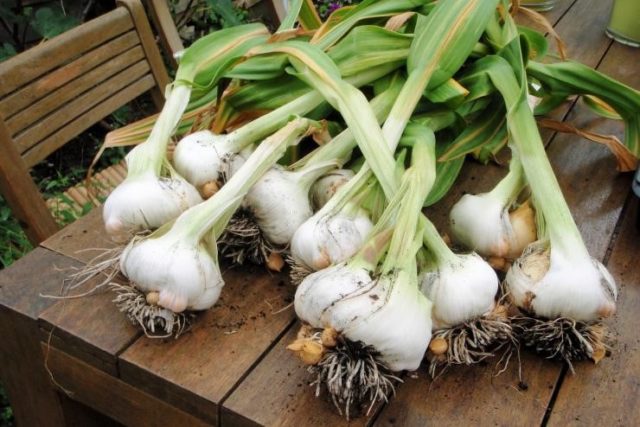
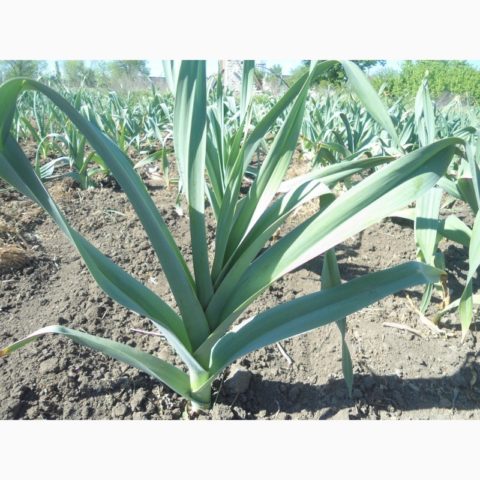
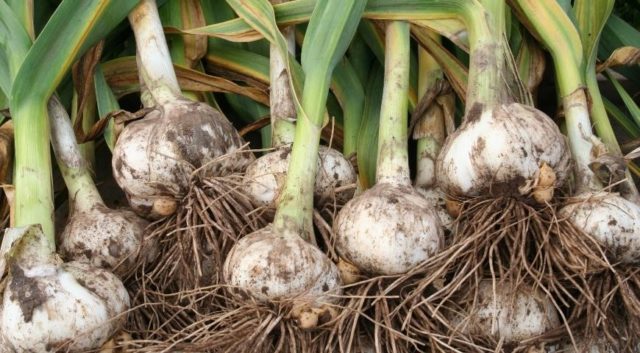


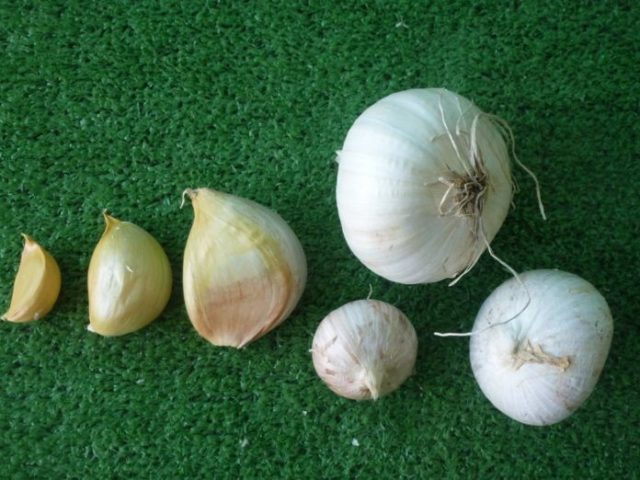
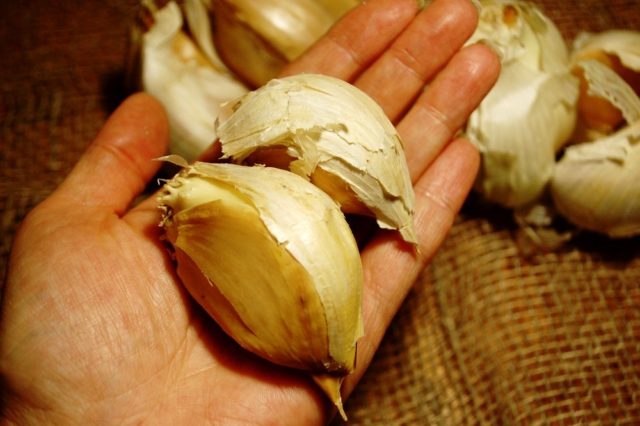
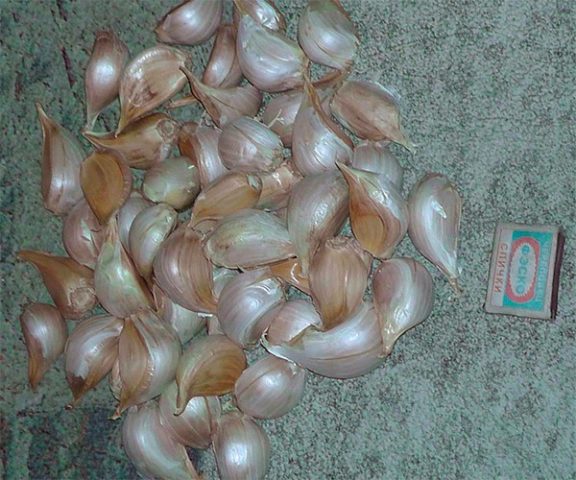











I planted my children before the winter, the purchased ones dried up by the spring .. I judged so I will throw it out anyway ... The experiment was a success. They hatched in the spring like winter garlic .. looking like a hero .. I'm sure the winter one will surpass .. Kemerovo region ..